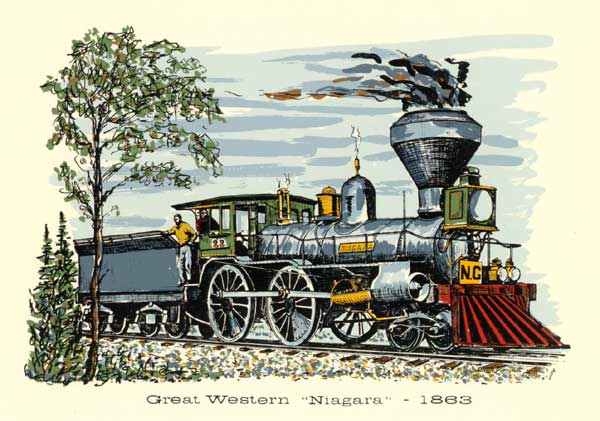
The NARROW GAUGE
by R.L.Kennedy
"The Narrow Gauge" is a phrase that carries with it much
history, evoking images of storied little railways of a bygone era long
ago - gone but not forgotten.
Narrow Gauge can also be used in a derisive manner. Railway lines built
to narrow gauge ran in many parts of the world and still do since in
some countries what we think of as narrow gauge is normal or standard
to them.
Colonial gauge, 3' 6" (42") was widely used throughout the
British Empire and remains in use in some former British countries.
There are many gauges around the world, including what is referred
to as broad gauge including India (5'6") and Russia (5'), but there
is only one gauge that is really "standard" it is 4' 8 1/2",
which originated in England where railways themselves originated. It
is the gauge used by almost every railway in North America, but this
wasn't always the case.
Common narrow gauges on this continent are 36" and 42", the former being
more prevalent, being
used by such roads as the White Pass & Yukon and most of the fabled
Colorado slim gauge lines.
The latter was much less common although it did serve the needs of Newfoundland
as well as several
other Canadian roads.
Early Toronto hosted a variety of railway widths. The
Northern Railway of Canada, the Grand
Trunk and the Great Western were all built to the old Provincial gauge
of 5' 6" mostly for military reasons. To prevent their use by enemy
forces invading Canada from the U.S.A!
Running northwest from Toronto was the 3'6" Toronto,
Grey & Bruce and northeast was the
Toronto & Nippising, also 3'6" for economy, but having no
connection to each other! The arrival of C.P.R. predecessors Credit
Valley and Ontario & Quebec, brought standard gauge to the area.
As Canada's railway network expanded and easy interchange
with US roads (most being Standard
gauge) was desired, railways were regauged to 4'8 1/2".
Old CNR railroaders, ex Grand Trunk to the core,
used to refer to the CPR as the "narrow gauge".
As a young railroader in the Parkdale Yards in downtown Toronto
I would hear us called just that. I used to think it was because the
TG&B which ran through Parkdale to the Queens Wharf cross-
ing the CNR (GWR) was narrow gauge. In fact there were two reasons because
both the TG&B and the Credit Valley (also in Parkdale) were narrow
when compared to the Great Western broad gauge which was then actually
considered normal. (When a third rail was added to handle standard gauge
trains the engines carried a big "NG" sign ( SEE PICTURE) on the front
to alert switchtenders.
It was here that the derisive or derogatory remarks came in to play,
although usually in a kidding way. Their remarks were double-edged as
they implied that both our width and our company was inferior to theirs.
But we got back at them with an even more derisive term. They were known
as the "wooden axle" road, an old term meaning a very dilapidated outfit
since nothing would run very well using wooden axles. TAKE THAT!
